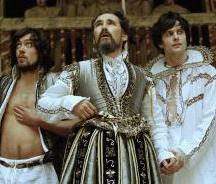SEARCH CurtainUp
REVIEWS
FEATURES
NEWS
Etcetera and
Short Term Listings
LISTINGS
Broadway
Off-Broadway
BOOKS and CDs
OTHER PLACES
Berkshires
London
LA/San Diego
DC
Philadelphia
Elsewhere
QUOTES
On TKTS
LETTERS TO EDITOR
FILM
LINKS
MISCELLANEOUS
Free Updates
Masthead
NYC Weather
 London Review
London Review
The Tempest
by Charlotte Loveridge
|
A confused noise within: We split, we split, we split
--- Prospero (in this production speaking Gonzalo's lines from the shipwreck) |

Alex Hassell, Mark Rylance and Edward Hogg
(Photo: John Tramper) |
Mark Rylance's final season as Artistic Director at the Globe after a successful ten years cannot help but have been eagerly awaited. Therefore, when Rylance decided on a version of The Tempest which has as much external frippery as a Benedictine monk, you feel there was a certain amount of playful baffling of these high expectations. This production has just three actors and three dancers, no scenery and little costume change. Instead, the imagination itself must recreate the magical isle and all its eerie happenings.
The actors (Mark Rylance, Alex Hasell and Edward Hogg) certainly have to work hard and use all their resources of versatility to embody the differing characters without the visual aid of separate costumes. They excellently achieve this, portraying very distinct figures whilst not slipping into two-dimensional caricatures. Mark Rylance's performance is charismatic and his Prospero is persuasively compelling. In the opening scene, there are no sound or lighting effects but the storm is created only by Prospero's puppeteering of a chess board. He enacts the nautical chaos like a child would play with toys. This sense of the magus' effortless power is obvious but the scene is also hilariously funny.
The whole production, in fact, is incredibly rich in humour. This is partly through exploiting the characters' doubling-up. For instance, Prospero's line to Miranda that Ferdinand "To th' most of men…is a Caliban" is given comic metatheatrical resonance by the fact that Alex Hassell plays both. Edward Hogg was outstanding in giving finely-timbred performances within a wide range of characters. His Ariel is dispassionate, his Miranda is tremulously emotional and his Trinculo comically camp but sharply different from his female incarnation.
Exciting physical movement, reminiscent of Shared Experience, is integral to this production. A heavy rope noose hangs in the centre of the stage. This single prop is a formidable symbol of power and coercion, as characters are noosed, trapped and swung. There are three dancers (Liz Collier, Fiona Creese, Sian Williams) who represent the Fates. Dressed in jeans and leather jackets, they are alien to the Jacobean-clad actors. Their biker-punk style means they are impervious to any control or rules and at one point they even raid the auditorium's statues for masks. Their active physicality is not just a visual spectacle, but also clarifies the play's meaning. In particular, their movements often convey the incomprehensible forces which control the humans. When Trinculo, Stephano and Caliban are drunk, the dancers manoeuvre their limbs in alcoholic disco-ordination. In addition to these six players, there are nine singers who sit in the gallery dressed as the Muses. Their song provides a sense of a divine framework which does not undercut significance of the mortal drama.
The thematic cohesion of this production provides a solid basis for its stimulating innovation. The dichotomous World and Underworld are embodied by the earthily covetous Caliban and the spiritually detached Ariel. Prospero learns to reconcile the two cosmic elements of Earth and Sky or body and mind inside his own psyche, embracing balance and reintegration into human society. This basic trinity serves as a paradigm for all the scenes so, for instance, Stephano is in the axis between Caliban and Trinculo. By using the same actors, parallels between characters are highlighted, such as Miranda's sheltered emotional experience with Ariel's impassive composure.
It is perhaps advisable to read a synopsis of the play before seeing this bravely original production because the narrative is at times slightly confusing and the Alonso, Gonzalo and Antonio scenes especially feel a bit marginalized. However, having said this, the imaginative gestures are lingeringly vivid, assaulting the mind's eye with breathtaking liveliness and inspired energy. The Tempest seems so suited to a special-effects laden production but Tim Carroll's direction exposes such apparatus as unnecessary. Instead, within a dramatic whirlwind conjured only by movement, song and poetry, Prospero's emotional journey is the focal point as the movingly human drama at the heart of this otherworldly play.
STOP PRESS
It has just been announced that Dominic Dromgoole will replace Mark Rylance as Artistic Director of Shakespeare's Globe from 2006. Dominic Dromgoole is at present Artistic Director of the Oxford Stage Company and previously ran The Bush Theatre.
| The Globe Season - The Tempest
Written by William Shakespeare Master of Play: Tim Carroll Starring: Mark Rylance (Prospero, Alonso, Sebastian, Stephano) With: Edward Hogg (Miranda, Ariel, Antonio, Trinculo) and Alex Hassell (Caliban, Ferdinand, Gonzalo) Master of Clothing, Properties and Hangings: Jenny Tiramani Master of Music/Composer: Claire van Kampen Master of Dance: Siãn Williams Master of the Words: Giles Block Master of Movement: Glynn MacDonald Master of Voice: Stewart Pearce Running time: Two hours ten minutes without an interval. Box Office: 020 7401 9919 Link to website: http://www.shakespeares-globe.org Booking to 2nd October 2005 Reviewed by Charlotte Loveridge based on 18th May 2005 performance at Shakespeare's Globe, New Globe Walk London SE1 (Tube Station: London Bridge/Mansion House via Millennium Bridge) |


Mendes at the Donmar
Our Review

Peter Ackroyd's History of London: The Biography

London Sketchbook

Retold by Tina Packer of Shakespeare & Co. Click image to buy.
Our Review

6, 500 Comparative Phrases including 800 Shakespearean Metaphors by CurtainUp's editor.
Click image to buy.
Go here for details and larger image.
